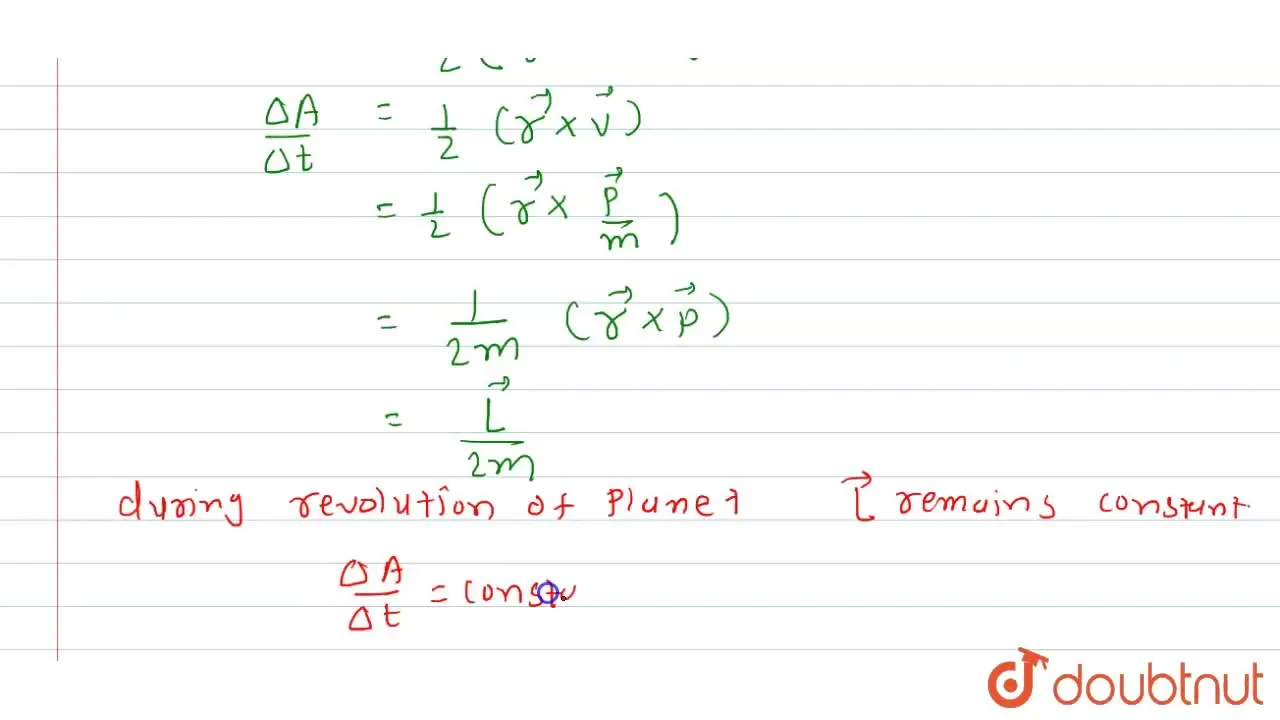State and prove Kepler's second law (Law of Areas) of planetary motion. Solution in Gujrati
⇒ ..The line that joins any planet to the sun sweeps equal areas in equal intervals of time... It is shown in figure.
⇒ The planet P moves around the sun in an elliptical orbit. The shaded area is the area ΔA swept out in a small interval of time Δt .
⇒ This law comes from the observations that planets appear to move slower when they are farther from the sun than when they are nearer.
⇒ The law of areas can be understood as a consequence of conservation of angular momentum which is valid for any central force.
⇒ The line of action of force which is acting on planet is passing through the sun, hence the torque τ=rFsinπ=0 . So the conservation of angular momentum of any planet remains constant.
⇒ Let the sun be at the origin and momentum of the planet be →rand→p .
⇒ The area swept out by the planet of mass m in time interval Δt is ΔA.
⇒ From figure area of right triangle ΔSPP.
(Note : For Δt→0)
ΔA=12× base × perpendicular
ΔA=12(→r×→vΔt) ...(1)
(Here , PP.=ΔS=vΔt )
⇒ Dividing Δt on both side of equation (1) ,
Δ→AΔt=12(→r×→v)
but momentum of planet →p=m→v
∴→v=→pm
∴Δ→AΔt=12(→r×→pm)
∴Δ→AΔt=12m(→r×→p)
∴Δ→AΔt=→L2m ...(2)
(∴→r×→p=→L Angular momentum )
⇒ Where Δ→AΔt is velocity, →L is angular momentum.
⇒ The gravitation force of sun on planet →F is opposite to →r and hence τ=0 and L = constant
⇒ So, during revolution of planet remains constant.
[ ∴ m is mass which remains constant]
∴Δ→AΔt = constant .....(3)
⇒ At This is Kepler law of areas for planetary motion.
Related Playlists
- BOOK - KUMAR PRAKASHANCHAPTER - GRAVITATIONEXERCISE - Section - A Try Yourself (VSQs)76videos
GRAVITATION
- BOOK - KUMAR PRAKASHANCHAPTER - GRAVITATIONEXERCISE - Section - B Numericals (Numerical From Textual Illustration)15videos
GRAVITATION
- BOOK - KUMAR PRAKASHANCHAPTER - LAW OF MOTIONEXERCISE - (QUESTION PAPER) SECTION-D1videos
LAW OF MOTION
Similar Questions
Describe Ptolemy model for planetary motion.
05:58View SolutionLet the speed of the planet at the perihelion P in figure .(a) be vp and the Sun - planet distance SP be rp . Relate {rp,vp} to the corresponding quantities at the apphelion {rA,vA} . Will the planet take equal take equal times to traverse BAC and CPB ?
 03:45View Solution
03:45View SolutionA 70 kg man stands in contact against the inner wall of a hollow cylindrical drum of radius 3 m rotating about its vertical axis with 200 rev/min. The coefficient of friction between the wall and his clothing is 0.15. What is the minimum rotational speed of the cylinder to enable the man to remain stuck to the wall (without falling) when the floor is suddenly removed ?
03:42View SolutionState Kepler's 1st law of planetary motion.
07:59View SolutionState Kepler's 2nd law of planetary motion.
04:09View SolutionState Kepler's 3rd law of planetary motion.
06:14View SolutionState Kepler's laws of planetary motion.
05:07View SolutionAccording to Kepler's second law of planetary motion,
01:31View SolutionState Kepler's Laws of planetary motion.
06:36View SolutionState Kepler's law of planetary motion.
03:34View SolutionState Kepler's II law of planetary motion (law of areas)
03:01View SolutionDeduce Kepler's second laws of planetary motion for a planet.
03:54View SolutionState and prove Kepler's second law (Law of Areas) of planetary motion.
03:45View SolutionState Kepler's second law of planetary motion.(law of areas)
View SolutionState Kepler's Laws of planetary motion.
OR
State kepler's law of orbit and law of equal areas.
OR
Any one law can be asked for
OR
State Kepler's law of equal areas.
OR
State Kepler's Law of period.02:43View Solution


